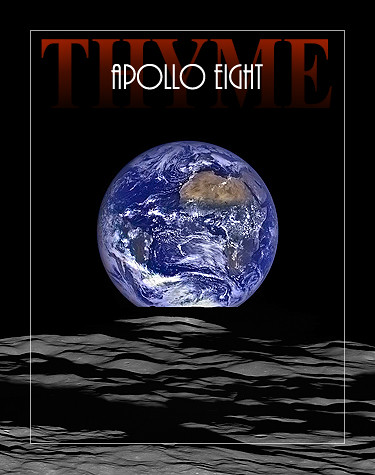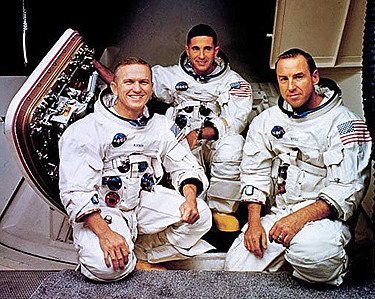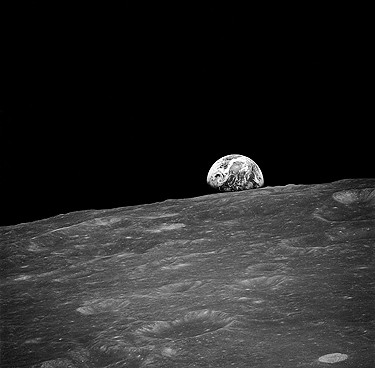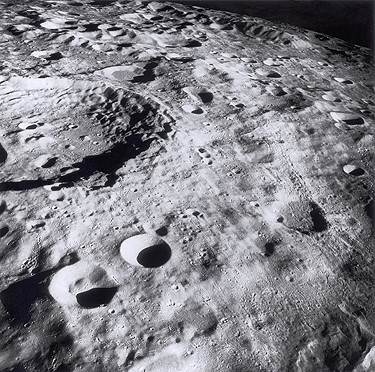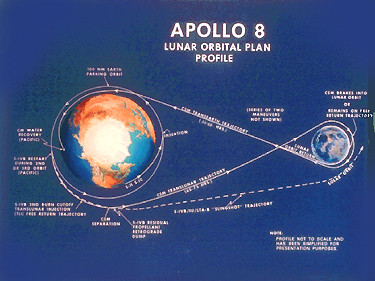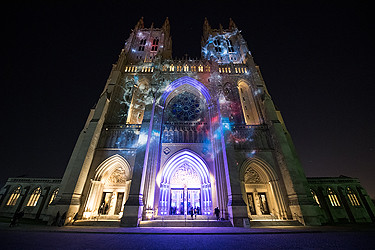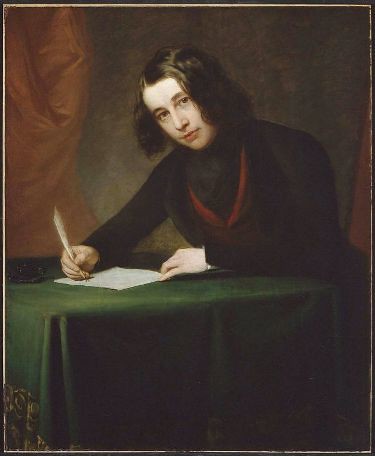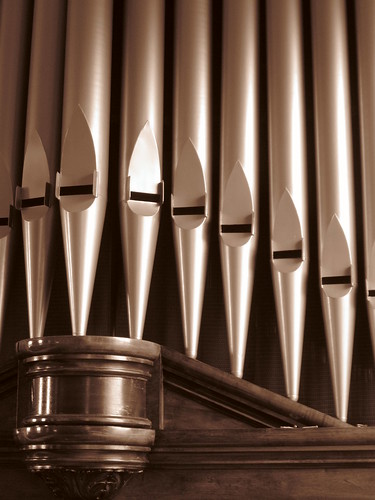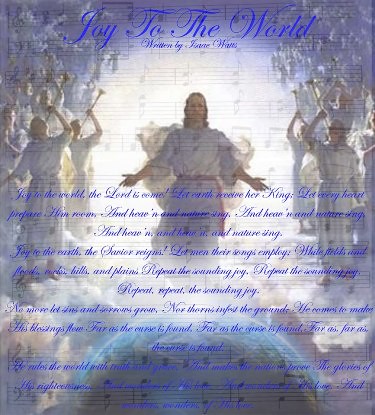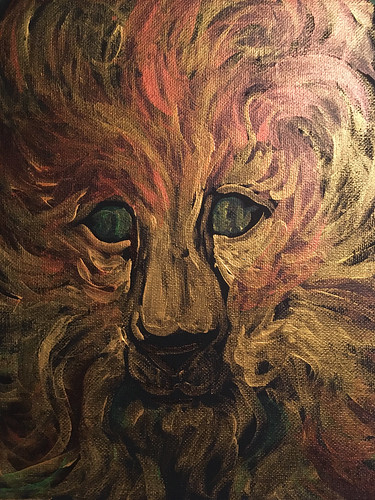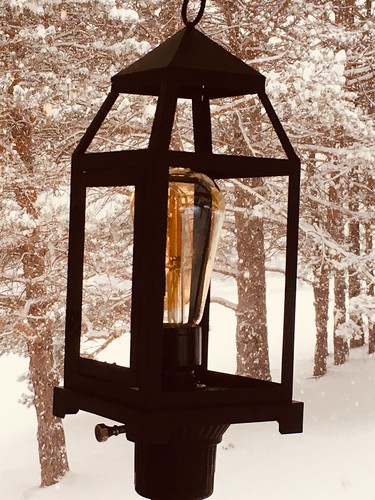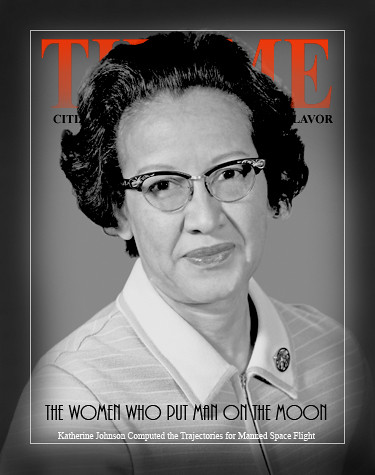
Volume XV, Issue XXVI
How Can I Have Faith?
Now faith is the substance of things hoped for, the evidence of things not seen.” – Hebrews 11:1
These Women Put Man on the Moon
Watching those old space shows as a child, it was pretty obvious that you just got into the spacecraft, took off and flew to wherever in the solar system you wanted to go. It looked deceptively simple – and it was! We had no reason to doubt that man had landed on the moon because Buck Rogers had made it look simple. But when President John F. Kennedy gave the imperative to actually put a man on the moon and bring him safely home, it immediately became clear that the problem was not so simple.
In order to go to the moon, you had to take off and steer a course to where the moon would be when you got there. You had to account for parabolic ascent and elliptical orbits. Your travel map existed in the realm of complex geometry and required brilliant mathematicians to chart. Fortunately the NASA Space Task Group at Langley Research Center had just such a group of mathematicians. They were mostly women and quite a few of them were African American! If you have seen the movie Hidden Figures you learned the stories of three of them, but the complex world of spaceflight engineering actually demanded many more. Many of them worked in the West Computing Group at Langley. Here Katherine Johnson and her colleagues mapped the stars for the astronauts. Yes, they literally mapped the heavens, so that the astronauts could navigate by the stars should their machine computers fail them.
This became essential in missions like Apollo 13, where the spacecraft was actually shut down at a time when critical course corrections had to be made. Katherine Johnson was one essential backup person who the navigation controllers in ‘the trench’ at Mission Control called in to calculate the trajectories of the revised mission. This was essential as you had to sling the Command Module and Lunar Module assembly around the moon about 65 miles from the surface. A miscalculation could have sent the spacecraft crashing to the lunar surface or missing the gravitational effect of the moon entirely – hurtling into deep space with no possibility of return.
To me, the complex mapping, verified by many earth orbit tests, is one reason I have little patience for the skeptics who say the lunar landing was somehow ‘faked.’ The careful calculations and critical launch windows only became known because the people who designed the mission really had to do it.
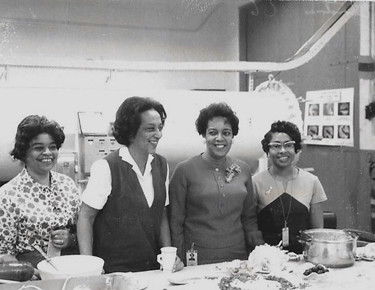
Some of Langley's first computers. NASA Photo.
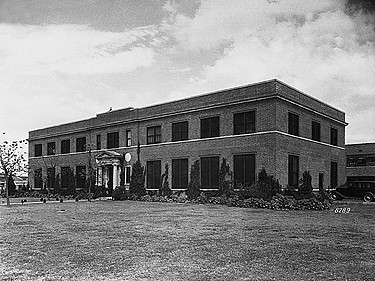
In this 1930's era building, the computers plotted man's path to the moon. NASA Photo.
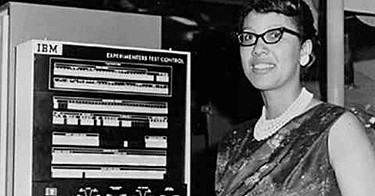
Dorothy Vaughn. NASA Photo.
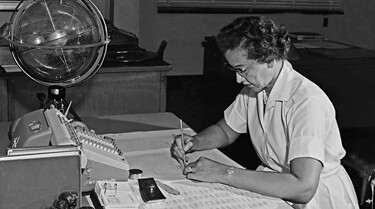
Katherine Johnson. NASA Photo.
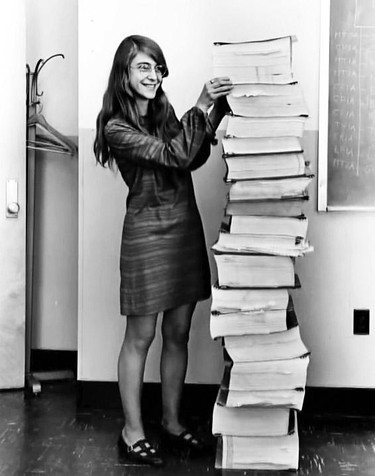
Margaret Hamilton with the printout of the Apollo AGC Software. NASA.
Margaret Hamilton
Software Engineer
Margaret Hamilton was 33 years old when she worked as director of software engineering at the MIT Instrumentation Laboratory. She and her team defined the design and testing criteria for the software that ran the onboard computer on the Lunar Module and developed the concepts of asynchronous flight software and priority scheduling which saved the Apollo computers from crashing during overloads such as the ones that occurred during the Apollo 11 descent to the moon (the 1201 and 1202 alarms).
The Journey of Apollo Eight

A particularly beautiful diagram of the journey to the moon.
(NASA)
Oleksandr Ignatyevich Shargei
[click to read]
Ukranian Spaceflight Scientist
On June 21, 1897 the world celebrates the birthday of Yuriy Vasilievich Kondratyuk, the famous Ukrainian author of the “route kondratyuka” which the Apollo spacecraft and Lunar Module took to the moon, creating the concept of Lunar Orbit Rendezvous. His real name is Oleksandr Ignatyevich Shargei. He changed it because of the danger posed by the Soviet Union to upper-class Ukranians. This did not prevent him from becoming one of the most famous inventors in the world. (read more)
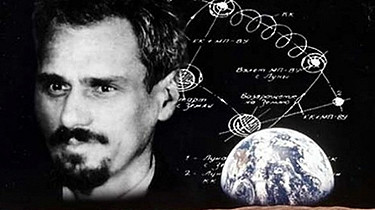
Oleksandr Ignatyevich Shargei plotted the course of Lunar Orbit Rendezvous, which was used to put Apollo astronauts on the moon. NASA's John Cornelius Houbolt and Thomas Dolan of Vought Astronautics referred to Sargei's work as they developed the concept for use by the Apollo program.
Tom Dolan and John Houbolt
Thomas Dolan was an American engineer who proposed the first fully developed concept of Lunar orbit rendezvous for the Apollo program while working at Vought Astronautics. Dolan referred to his LOR study concept as Manned Lunar Landing and Return (MALLAR), and it was largely ignored by NASA administrators until Langley engineer John Houbolt began championing the concept in 1961. The proposed idea outlined a smaller spacecraft dedicated only to operate in the vacuum of space. This spacecraft could act as sort of a shuttle between an orbiting "command module" in Lunar orbit and the surface of the Moon. Following this mission profile required the Command/Service Module and Lunar Module to fly all the way to the moon together and undock while in orbit around the moon, at which point the Lunar Module would land on the moon. In order to return, it would lift off again into lunar orbit and perform an orbital rendezvous with the Command/Service Module. The lander's ascent stage would be left behind in orbit, and the crew would return home using the Command/Service Module. This method saved a lot of weight in propellant and spacecraft mass, but did not gain widespread acceptance early on. The risks associated with Lunar orbit rendezvous were initially considered unacceptable by NASA officials. The Gemini missions would later prove that rendezvous and docking was indeed possible in space, paving the way for Dolan's idea to be put into practice. John Cornelius Houbolt was an aerospace engineer credited with leading the team behind the lunar orbit rendezvous (LOR) mission mode, a concept that was used to successfully land humans on the Moon and return them to Earth. This flight path was first endorsed by Wernher von Braun in June 1961 and was chosen for Apollo program in early 1962. The critical decision to use LOR was viewed as vital to ensuring that Man reached the Moon by the end of the decade as proposed by President John F. Kennedy. In the process, LOR saved time and billions of dollars by efficiently using existing rocket technology. (Wikipedia)
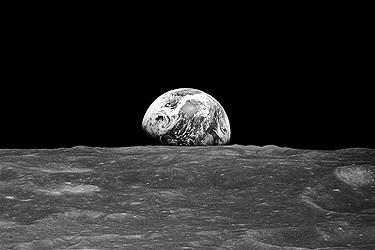
'Earthrise' Photo enhanced by Lunar Reconnaissance Orbiter Imagery. NASA Photo.
Revisiting 'Earthrise'
Lunar Reconnaissance Orbiter
Reading from Genesis
Creating the Lunar Module
The Golden Age of Russian Space Exploration
Christmas Eve 1968:
[click to read]
The Apollo 8 Astronauts and Me
By Brian Scully
On Christmas Eve, 1968, the Apollo 8 astronauts were attempting to do something no human being had ever done before: They were going to try to get my cheapskate father to buy my family our first color television.
Oh yeah, and they were also going to the Moon.
Fifty years ago, on December 21st, 1968, the Apollo 8 astronauts blasted off the Earth from Cape Kennedy and, although they weren’t going to land on the moon, they were going to orbit it and televise it to us all “live” from their space capsule on Christmas Eve. The astronauts, Frank Borman, Jim Lovell and Bill Anders, were risking their lives in this dangerous mission to advance science, to give some good news to a world that desperately needed good news… and to get my dad to buy us a color TV and give me the best Christmas of my life! I add that only so you can see that I also had some skin in the game.
For those of you who weren’t around back then, 1968 was a year of terrible pain in America. The war in Vietnam was spiraling out of control with no end in sight. And just about every family in any big city or small town knew a soldier who had been wounded or died fighting in a country that none of us had ever been to, or knew much about. In 1968 Dr. Martin Luther King and Robert F. Kennedy were fighting for peace, civil rights and an end to violence… and were themselves shot and killed. It was a time when people seemed to stop having friendly conversations with their neighbors across the fence and started angrily hollering at each other in political protests on inner city streets and college campuses.
Just about every morning in 1968 the country woke up to bad news that was worse than the day before. But to a 15 year-old me and my 12 and 7 year-old brothers, the worst news of 1968 was that we still had to watch our favorite TV shows on a crummy black and white television set. Don’t get me wrong, we felt bad about all those other things that were happening in America too. We had seen it all on the TV news, but, just, you know… in black and white. I’m sure we’d have felt much worse if we had seen it in color.
Now, in case you are thinking that color televisions were a pretty rare thing in 1968, well, they were not. Most all of the families in our neighborhood had a color TV. And by 1968, just about every show on all three TV networks was in color. Most other kids could see Adam West’s royal blue cape on “Batman”, Opie’s red hair on “The Andy Griffith Show” and Little Joe Cartwright’s lime green jacket, lavender shirt and tight fawn-beige pants on “Bonanza”. (That might explain why Little Joe got beat up so much by the less tolerant cowboys on the Ponderosa.)
Watching TV in black and white made no sense to my brothers and me. If we went to the local theater, the movies were in color. The pictures that our family’s Kodak Instamatic camera took of us on birthdays, vacations and whenever my youngest brother Neil’s swim trunks fell off, were all in color. Everything my brothers and I saw in our everyday lives was in color. Except for when we got home and turned on our television. And that is because we did not live in “Walt Disney’s Wonderful World of Color”. We lived in Dick Scully’s Crappy World of Black and White.
Dick Scully was my father and he was the only thing standing between me and a color TV. Dad didn’t like spending money on things he considered to be an unnecessary expense… things like name-brand cookies, college educations, and Stingray bikes with monkey handle bars and cool banana seats. And my father considered a color TV the most unnecessary expense of them all. Well, maybe the second-most unnecessary expense after my mother’s visit to the doctor for her annual mammogram.
Every year I spend money that we could be using for other things on that damn test and what does it ever show, Geraldine? Nothing! Every year, absolutely nothing!” He actually made my mother feel guilty for not having cancer. Like if it weren’t for her disappointing mammograms, we’d be eating Oreos instead of Shop-Rite cookies. That was my father.
Every month or so, for years, my brothers and I asked our dad to buy a color TV and every time his answer was the same, if you don’t count swears. “We can’t afford it.” Now, we certainly weren’t rich, but my father made a good living. He had a small dry cleaning store and most of the people in the neighborhood came to him to get the stains out of their clothes. As Dad used to say, “Blood and vomit are our bread and butter.” It would have seemed impossible to make the phrase “Blood and vomit” even more disgusting in a sentence, but my father managed to do it.
My mother also tried to get him to buy a color set for us, but she was more clever and subtle than we were. I remember one time when she said, “Dick, I know you love the kids and they know you love them too. If you say that we can’t afford a color TV, we all believe you. But I was thinking… the boys have also always wanted a cat too and we can get a cat for free, so, if they can’t have a color television, why not let them have a cat instead?” Mom knew our father hated cats, so this was a brilliant plan. If asked, I would have said he hated cats more than he hated spending money on a color television. I would have been wrong. He got us a cat. The irony that it was a black and white cat was not lost on me.
If it sounds like I had the crummiest life of anyone in our neighborhood, well, I didn’t. There was one kid in my school who had it even worse than me… Ralph Forgey. The Forgeys were pretty poor and had a black and white TV like us, but the picture tube had burned out on theirs a few years earlier. They couldn’t see anything on the screen, but the sound still worked, so Ralph Forgey and his family could only listen to TV shows. Maybe that’s why Mrs. Forgey couldn’t understand how some nice girl hadn’t snapped up Liberace yet.
Since it looked like we were never getting a color television, I tried to find ways to watch my favorite shows on other people’s color TVs. My first choice would have been to watch TV over at one of my friends’ houses. The only problem was most of my friends’ parents didn’t like me much, so I was rarely ever invited inside. Some nonsense about things always getting broken whenever I visited. I was considered an “outdoors friend”.
I got so desperate to watch color TV that I came up with a plan that would get me into the house of any kid in my school, even if I never met him. The idea was that I would “find” the kid’s lost jacket and bring it around to his house at about 7:30 that evening, when network TV shows were starting up. Of course, the jacket was never “lost” at all… I had swiped it during the day at school. The plan was that the kid’s parents would be so grateful to me for having found the jacket that I would naturally be invited into their home and would get to watch their color TV with them. Unfortunately, that was never successful because by the time I got to their house, the poor kid had already gotten a beating for losing his jacket and the family was in a bad mood because of the whole thing. On paper though, that one should’ve worked.
Scams like that came to an end when it was announced that the Apollo 8 astronauts were going to the moon and would show it to us all on live television on Christmas Eve. That night at supper, I asked Dad to buy us a color TV again. He had his usual four-word-answer ready… “We can’t afford it.” But I was ready too, because for the first time, I had a good reason for us having a color TV. My brothers and I needed to see the Apollo 8 mission in color for our science classes at school. This time it was for education: The ultimate scam in any kid’s playbook. He replied with a first-ever five-word-answer… “We still can’t afford it.”
Oh man, if the first trip to the moon and education wasn’t enough to get us a color TV, nothing was. I launched into an angry, desperate plea for a color television that both my brothers joined in on. My mom stood next to us in solidarity, however she was holding the cat and I wasn’t sure if that was going to help us or hurt us. “Dick, let’s stop having this same old argument. It’s almost Christmas and this is the perfect time to finally get a color TV. The astronauts are going around the moon for the first time ever and I think our kids should get to see history being made in color like all the other kids in America!” My brothers and I cheered and, to my recollection, the cat meowed.
Dad actually seemed to consider it for a moment. We all held our breaths in anticipation, then he said, “Look, I’d love to have a color TV just like the rest of you but we just can’t afford it…” His voice trailed off as he lit up a cigarette and puffed on it self-satisfied, sure of another victory. But not this time. Mom was ready. “Well, I’ve found a way that we can afford it, “ she said. “I’m going to pay for it myself. I got a job.”
Dad was clearly caught off guard by this new development. “What? A job? Oh come on, Gerri, you can’t be serious… "
Mom told him she was going back to being a waitress, like she was before they were married. My father, not buying any of this, picked up his newspaper and flipped through the pages, snorting, “Sure you are. What restaurant would hire you after all this time?” My mother replied cheerfully, “The Blue Star Tavern” over on Fairview Avenue. I start tomorrow.”
My father leapt up from his chair. “The Blue Star Tavern?! That’s where I eat lunch! I don’t want my wife around when I’m eating lunch!”
You boys can come in during your Christmas vacation and eat for free”, Mom continued. “The job even comes with two uniforms and—“
You get to wear a uniform?” my little brother, Neil, asked, impressed. Mom answered, “Well, they’re not really uniforms… just a nice blouse, a pair of pants and— “
Dad nearly choked! “Pants?!” “Pants!!” he exclaimed a second time to fully register his shock. “No wife of mine is getting a job or wearing pants!”
Panic had set in and my father started begging. “C’mon, Ger’… you can’t do this to me. If you start working, people will think it’s because I don’t make enough money.” Mom countered with, “Well, won’t they think that anyway because we’re just about the only family in the neighborhood that doesn’t have a color television?”
For the first time in his life, my father couldn’t think of something to say. Not even something stupid. Mom just cheerfully continued, “Do you need the car every day, Dick, or do you think we should get another one for me too?” she asked.
Dad angrily snuffed out his cigarette in the ashtray, “I’m putting a stop to this right now!” He reached into his back pocket for his wallet and opened it. If this were a cartoon, the wallet would have had moths flying out of it. Since this was real life, it just smelled bad. He counted out three-hundred dollars in twenties and handed them to my mother, bellowing “Get the damn color TV, but no job… you hear me, girl?!”
I couldn’t believe it… we were actually going to get a color television. I didn’t know what to say. My mom knew what to say, though, as she turned to my dad and gave him a peck on the cheek, “Thanks, honey.”
My father lit another cigarette and fell back into his chair, muttering, “There’s no way Richard F. Scully’s wife is going to be waiting hand and foot on anyone!” He then turned to my mother and barked, “Now go fix me a peanut butter sandwich… and make it snappy!” [read more]

Volume XV, Issue XXVIa
Phantasies
By George MacDonald, Chapter 9
O lady! we receive but what we give,
And in our life alone does nature live:
Ours is her wedding garments ours her shroud!
Ah! from the soul itself must issue forth,
A light, a glory, a fair luminous cloud,
Enveloping the Earth--
And from the soul itself must there be sent
A sweet and potent voice of its own birth,
Of all sweet sounds the life and element!"
~ from Samuel Taylor Coleridge's "Dejection: An Ode".
From this time, until I arrived at the palace of Fairy Land, I can attempt no consecutive account of my wanderings and adventures. Everything, henceforward, existed for me in its relation to my attendant. What influence he exercised upon everything into contact with which I was brought, may be understood from a few detached instances. To begin with this very day on which he first joined me: after I had walked heartlessly along for two or three hours, I was very weary, and lay down to rest in a most delightful part of the forest, carpeted with wild flowers. I lay for half an hour in a dull repose, and then got up to pursue my way. The flowers on the spot where I had lain were crushed to the earth: but I saw that they would soon lift their heads and rejoice again in the sun and air. Not so those on which my shadow had lain. The very outline of it could be traced in the withered lifeless grass, and the scorched and shrivelled flowers which stood there, dead, and hopeless of any resurrection. I shuddered, and hastened away with sad forebodings.
In a few days, I had reason to dread an extension of its baleful influences from the fact, that it was no longer confined to one position in regard to myself. Hitherto, when seized with an irresistible desire to look on my evil demon (which longing would unaccountably seize me at any moment, returning at longer or shorter intervals, sometimes every minute), I had to turn my head backwards, and look over my shoulder; in which position, as long as I could retain it, I was fascinated. But one day, having come out on a clear grassy hill, which commanded a glorious prospect, though of what I cannot now tell, my shadow moved round, and came in front of me. And, presently, a new manifestation increased my distress. For it began to coruscate, and shoot out on all sides a radiation of dim shadow. These rays of gloom issued from the central shadow as from a black sun, lengthening and shortening with continual change. But wherever a ray struck, that part of earth, or sea, or sky, became void, and desert, and sad to my heart. On this, the first development of its new power, one ray shot out beyond the rest, seeming to lengthen infinitely, until it smote the great sun on the face, which withered and darkened beneath the blow. I turned away and went on. The shadow retreated to its former position; and when I looked again, it had drawn in all its spears of darkness, and followed like a dog at my heels.
Once, as I passed by a cottage, there came out a lovely fairy child, with two wondrous toys, one in each hand. The one was the tube through which the fairy-gifted poet looks when he beholds the same thing everywhere; the other that through which he looks when he combines into new forms of loveliness those images of beauty which his own choice has gathered from all regions wherein he has travelled. Round the child's head was an aureole of emanating rays. As I looked at him in wonder and delight, round crept from behind me the something dark, and the child stood in my shadow. Straightway he was a commonplace boy, with a rough broad-brimmed straw hat, through which brim the sun shone from behind. The toys he carried were a multiplying-glass and a kaleidoscope. I sighed and departed.
One evening, as a great silent flood of western gold flowed through an avenue in the woods, down the stream, just as when I saw him first, came the sad knight, riding on his chestnut steed.
But his armour did not shine half so red as when I saw him first.
Many a blow of mighty sword and axe, turned aside by the strength of his mail, and glancing adown the surface, had swept from its path the fretted rust, and the glorious steel had answered the kindly blow with the thanks of returning light. These streaks and spots made his armour look like the floor of a forest in the sunlight. His forehead was higher than before, for the contracting wrinkles were nearly gone; and the sadness that remained on his face was the sadness of a dewy summer twilight, not that of a frosty autumn morn. He, too, had met the Alder-maiden as I, but he had plunged into the torrent of mighty deeds, and the stain was nearly washed away. No shadow followed him. He had not entered the dark house; he had not had time to open the closet door. "Will he ever look in?" I said to myself. "Must his shadow find him some day?" But I could not answer my own questions.
We travelled together for two days, and I began to love him. It was plain that he suspected my story in some degree; and I saw him once or twice looking curiously and anxiously at my attendant gloom, which all this time had remained very obsequiously behind me; but I offered no explanation, and he asked none. Shame at my neglect of his warning, and a horror which shrunk from even alluding to its cause, kept me silent; till, on the evening of the second day, some noble words from my companion roused all my heart; and I was at the point of falling on his neck, and telling him the whole story; seeking, if not for helpful advice, for of that I was hopeless, yet for the comfort of sympathy--when round slid the shadow and inwrapt my friend; and I could not trust him.
The glory of his brow vanished; the light of his eye grew cold; and I held my peace. The next morning we parted.
But the most dreadful thing of all was, that I now began to feel something like satisfaction in the presence of the shadow. I began to be rather vain of my attendant, saying to myself, "In a land like this, with so many illusions everywhere, I need his aid to disenchant the things around me. He does away with all appearances, and shows me things in their true colour and form. And I am not one to be fooled with the vanities of the common crowd. I will not see beauty where there is none. I will dare to behold things as they are. And if I live in a waste instead of a paradise, I will live knowing where I live." But of this a certain exercise of his power which soon followed quite cured me, turning my feelings towards him once more into loathing and distrust. It was thus:
One bright noon, a little maiden joined me, coming through the wood in a direction at right angles to my path. She came along singing and dancing, happy as a child, though she seemed almost a woman. In her hands--now in one, now in another--she carried a small globe, bright and clear as the purest crystal. This seemed at once her plaything and her greatest treasure. At one moment, you would have thought her utterly careless of it, and at another, overwhelmed with anxiety for its safety. But I believe she was taking care of it all the time, perhaps not least when least occupied about it. She stopped by me with a smile, and bade me good day with the sweetest voice. I felt a wonderful liking to the child--for she produced on me more the impression of a child, though my understanding told me differently. We talked a little, and then walked on together in the direction I had been pursuing. I asked her about the globe she carried, but getting no definite answer, I held out my hand to take it. She drew back, and said, but smiling almost invitingly the while, "You must not touch it;"--then, after a moment's pause--"Or if you do, it must be very gently." I touched it with a finger. A slight vibratory motion arose in it, accompanied, or perhaps manifested, by a faint sweet sound. I touched it again, and the sound increased. I touched it the third time: a tiny torrent of harmony rolled out of the little globe. She would not let me touch it any more.
We travelled on together all that day. She left me when twilight came on; but next day, at noon, she met me as before, and again we travelled till evening. The third day she came once more at noon, and we walked on together. Now, though we had talked about a great many things connected with Fairy Land, and the life she had led hitherto, I had never been able to learn anything about the globe. This day, however, as we went on, the shadow glided round and inwrapt the maiden. It could not change her. But my desire to know about the globe, which in his gloom began to waver as with an inward light, and to shoot out flashes of many-coloured flame, grew irresistible. I put out both my hands and laid hold of it. It began to sound as before. The sound rapidly increased, till it grew a low tempest of harmony, and the globe trembled, and quivered, and throbbed between my hands. I had not the heart to pull it away from the maiden, though I held it in spite of her attempts to take it from me; yes, I shame to say, in spite of her prayers, and, at last, her tears. The music went on growing in, intensity and complication of tones, and the globe vibrated and heaved; till at last it burst in our hands, and a black vapour broke upwards from out of it; then turned, as if blown sideways, and enveloped the maiden, hiding even the shadow in its blackness. She held fast the fragments, which I abandoned, and fled from me into the forest in the direction whence she had come, wailing like a child, and crying, "You have broken my globe; my globe is broken--my globe is broken!" I followed her, in the hope of comforting her; but had not pursued her far, before a sudden cold gust of wind bowed the tree-tops above us, and swept through their stems around us; a great cloud overspread the day, and a fierce tempest came on, in which I lost sight of her. It lies heavy on my heart to this hour. At night, ere I fall asleep, often, whatever I may be thinking about, I suddenly hear her voice, crying out, "You have broken my globe; my globe is broken; ah, my globe!"
Here I will mention one more strange thing; but whether this peculiarity was owing to my shadow at all, I am not able to assure myself. I came to a village, the inhabitants of which could not at first sight be distinguished from the dwellers in our land. They rather avoided than sought my company, though they were very pleasant when I addressed them. But at last I observed, that whenever I came within a certain distance of any one of them, which distance, however, varied with different individuals, the whole appearance of the person began to change; and this change increased in degree as I approached. When I receded to the former distance, the former appearance was restored. The nature of the change was grotesque, following no fixed rule. The nearest resemblance to it that I know, is the distortion produced in your countenance when you look at it as reflected in a concave or convex surface--say, either side of a bright spoon. Of this phenomenon I first became aware in rather a ludicrous way. My host's daughter was a very pleasant pretty girl, who made herself more agreeable to me than most of those about me. For some days my companion-shadow had been less obtrusive than usual; and such was the reaction of spirits occasioned by the simple mitigation of torment, that, although I had cause enough besides to be gloomy, I felt light and comparatively happy. My impression is, that she was quite aware of the law of appearances that existed between the people of the place and myself, and had resolved to amuse herself at my expense; for one evening, after some jesting and raillery, she, somehow or other, provoked me to attempt to kiss her. But she was well defended from any assault of the kind. Her countenance became, of a sudden, absurdly hideous; the pretty mouth was elongated and otherwise amplified sufficiently to have allowed of six simultaneous kisses. I started back in bewildered dismay; she burst into the merriest fit of laughter, and ran from the room. I soon found that the same undefinable law of change operated between me and all the other villagers; and that, to feel I was in pleasant company, it was absolutely necessary for me to discover and observe the right focal distance between myself and each one with whom I had to do. This done, all went pleasantly enough. Whether, when I happened to neglect this precaution, I presented to them an equally ridiculous appearance, I did not ascertain; but I presume that the alteration was common to the approximating parties. I was likewise unable to determine whether I was a necessary party to the production of this strange transformation, or whether it took place as well, under the given circumstances, between the inhabitants themselves.
(to be continued)
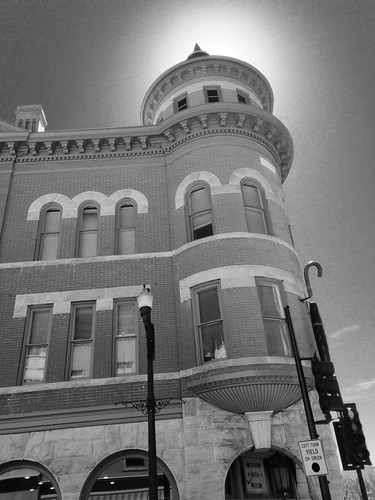
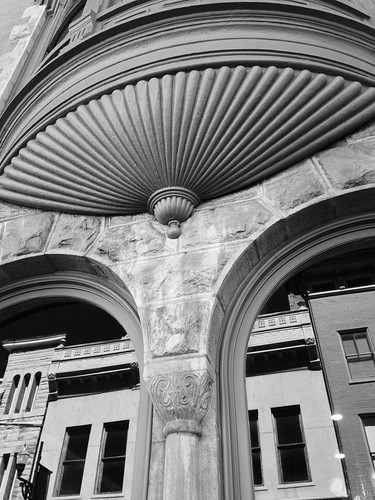
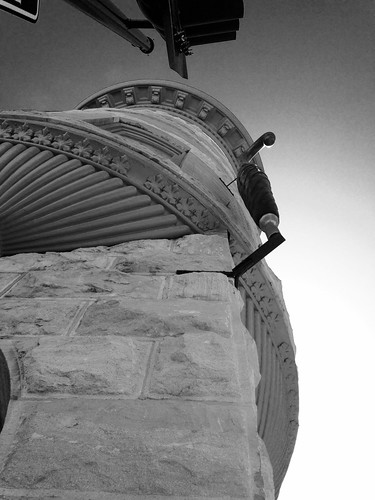
Staunton's Romanesque-Revival Marquis Building, constructed in 1895, originally housed the offices of architect T. J. Collins. Collins is responsible for the design of over 200 buildings in the historic city. A men's clothing shop once occupied the street level and the large umbrella was installed on the facade as a trade sign. Today the building is often referred to as 'The Umbrella Building.' -- Photos by Bob Kirchman
'The Light Within'
Painting by Savhanna Herndon

'The Light Within,' Acrylic on Canvas, 20" x 24" by Savhanna Herndon. This is a painting exploring the concept of IMAGO DEI and the Spirit of God within us (Romans 8:9).
And I heard a great voice out of heaven saying, Behold, the tabernacle of God is with men, and he will dwell with them, and they shall be his people, and God himself shall be with them, and be their God." -- Revelation 21:3
Tabernacle Presbyterian Church in Waynesboro, Virginia was host to a wonderful celebration of art centered around the theme of God tabernacling among His People. It was part of the church's celebration of its 25th anniversary. There was an art exhibition with music and refreshments. When the theme was announced it was obvious what pieces we should offer to the show.
'Journey to Jesus'
Mural by Kristina Elaine Greer and Bob Kirchman


Journey to Jesus, a mural depicting the nations coming to Jesus in the New Heaven and New Earth described in Revelation 21. Mural by Kristina Elaine Greer and Bob Kirchman.
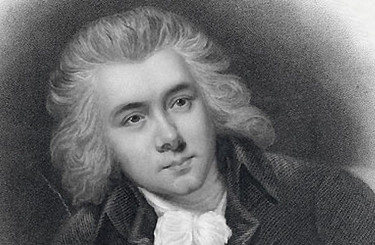
Public Service as a Holy Calling
The Life of William Wilberforce
When we really understand how short and uncertain our life is here, then we see things in their true proportions; we are prompted to act out of the conviction that “the night cometh when no man can work.” This thought produces a firm texture to our lives; it hardens us against the wind of fortune, and keeps us from being deeply penetrated by the cares and interests, the good or evil of this transitory state. When we have a realistic impression of the relative value of temporal and eternal things, this helps our souls maintain a dignified composure through all the vicissitudes of life. It brings our diligence to life, while it moderates our impulsive passions; it urges us to pursue justice, yet it checks any undue worry about the success of our endeavors.” – William Wilberforce
Get used to paying close attention to all those who live in a careless and inconsiderate world, who are in such imminent danger and are so ignorant of their peril. Think about these people, until you feel pity for them. This sympathy will melt your heart. Once there is room in your heart for Christ’s love, this will produce – almost without your noticing – a habitual feeling of gentle sympathy.” – William Wilberforce
Philosophy is designed only for those who are educated. It tends to divide society even more, breaking it into two parts: those who have money and leisure for learning, and those who don’t. But – blessed be God – the faith that I am recommending was designed not for the rich but the poor. It removes the distinction of class and wealth, and changes the entire social fabric. This faith makes all people useful members of civil society.” – William Wilberforce
Although Wilberforce is most known today for his work as an abolitionist, it is well to remember that for him the ‘Reformation of Manners’ had far more to do with the moral fiber of the nation as a whole. Does Wilberforce have a message for modern society? If you consider that the culture he lived in was a mess and needed badly the reform that subsequently guided it, the answer is a resounding “Yes!” Those who desire a compassionate society would do well to heed him. Those who seek a ‘compassionate’ society apart from Divine oversight would do well to remember that “if God does not exist, is murder permissible?” is one question that will quickly arise. Indeed one should ask if a neutral pluralism is to be pursued to the exclusion of virtues found in Holy Writ. Today Wilberforce’s Britain wrestles with this. She has widely embraced secularism, but has elected Prime Minister Theresa May, a devout Christian, who says unequivocally that Britain is a “Christian Nation.” Prime Minister May, like Wilberforce, is guided in her public service by her personal faith. These are difficult days for England, but the foundations built by Wilberforce will serve her well in the days ahead.
(to be continued)
The Wizard and the Prophet
Futurists and What Drives Them
Harari sketches a dystopian future in the hopes that doing so will prevent it. Like all prophets, he prophesies to prevent the prophecy, not to predict it.” –John Faithful Hamer
I found this quote in a book review and I have to agree that the Prophets of old put forth their dystopian vision in Scripture not desiring to see it, but in the hopes that it would be averted. Indeed Jeremiah 29;11 makes the mind of the Divine clear: “For I know the thoughts that I think toward you, saith the LORD, thoughts of peace, and not of evil, to give you an expected end.” That is how I read the prophets of old – that is how I read a lot of modern ‘dystopian’ fiction. Those of you who have followed THYME for a while know how when a family member handed me a novel about a series of ‘revelations’ surrounding 9/11 I took it in just that way. Unfortunately the author was appearing on the Jim Bakker Show hawking overpriced ‘survival buckets.’ When coupled with the ‘Blood Moon’ videos by John Hagee, we’re no longer trying to lead humanity away from disaster, we’re proclaiming it. And we’re bringing in profit to boot.
Never mind that the prophets of old did NOT make big bucks or go on book tours. Never mind that they were persecuted and sometimes lost their lives – I like to think that the true mission of the writer is to both lead us away from disaster and to lead us toward a brighter future. Jules Verne indeed envisioned a marvelous world of modern machines but he also was an astute observer of human nature. Consider characters like Captain Nemo. Consider as well his unpublished work: Paris in the Twentieth Century. Verne’s publisher rejected it as too dark – too dystopian. I think Verne is a great example of how to ponder both the wonder of the future and the dangers. That he tried to do both makes him great in my mind.

Untitled Painting by Savhanna Herndon.
Wizards and Prophets
By John Faithful Hamer
[click to read]
In The Wizard and the Prophet (2018), Charles C. Mann maintains that intellectual life in the 21st century is defined by a civil war between Wizards, who believe that technology will save us, and Prophets, who see various kinds of disaster on the horizon: “Prophets look at the world as finite, and people as constrained by their environment. Wizards see possibilities as inexhaustible, and humans as wily managers of the planet. One views growth and development as the lot and blessing of our species; others regard stability and preservation as our future and our goal. Wizards regard Earth as a toolbox, its contents freely available for use; Prophets think of the natural world as embodying an overarching order that should not casually be disturbed.” Steven Pinker, the author of Enlightenment Now: The Case for Reason, Science, Humanism, and Progress (2018), is a Wizard. Yuval Noah Harari, the author of Homo Deus: A Brief History of Tomorrow (2015), is a Prophet. (read more)

Bee and Rhododendron. Photo by Bob Kirchman.
Message in Our Missives
Christian Creatives in a Fallen World
[click to read]
Hi, I'm Lela Markham and this is my inaugural post on Delia Talent. I write speculative fiction, primarily, while delving into other genres on occasion. I'm one of those Christian creatives who does not advertise my works as "Christian". Historically, Christian creatives didn't claim a territory and label themselves. We don't think of Bach as a "Christian" musician, but rather a great composer who made his living as a church organist. Unless you're a history geek like me, you might not know about his deep and abiding faith. Although we now think of C. S. Lewis as a "Christian" author, his fictional works weren't advised as such when he was publishing because Christians of that era hadn't decided to paint themselves into a box with a label. Back when I was a kid Elvis Presley (not an example of a "good" Christian, but a man with a church background) and Johnny Cash (by that time, a reprobate saved by Christ) were singing gospel tunes right along with their secular tunes on regular radio ... and my non-believing parents didn't find that the least bit odd. (read more)

Hari and Penka Atanasov. Advancing Native Missions Photo.
In Search of the Light
Hari and Penka Atanasov
By Dee Brookshire
[click to read]
The canvas was called “Morning in Gethsemane.” After a night of agony, Jesus’ surrender to the Father’s will was illuminated by a light extending from heaven to earth. A Turkish lady from the Bulgarian parliament approached Hari and Penka Atanasov to express how this painting had touched her life. (read more)

Sunset over House Mountain. Photo by Bob Kirchman.
On Calling and IMAGO DEI
Discerning the Strokes of the Master
O Master Maker! Thy exultant art
Goes forth in making makers.”
—George MacDonald
If George MacDonald is correct in asserting that all wickedness tends to destroy individuality, then the Christian should have more individuality than anyone else. Purged of the encumbering weight of the wicked self and knighted by the accolade of the All-Sufficient, he should demonstrate daily the abundance that is repeatedly declared to be in Christ. Macdonald says of the white stone with the new name in the Book of Revelation that it is given because it expresses “the character, the nature, the meaning of the person who bears it. It is the man’s own symbol—his soul’s picture, in a word—the sign which belongs to him and no one else.” The great Creator Artist wants to render not only a Christian in His image but at the same time produce a portrait of the real qua man (for it is man and not the angels who are saves) relieved of the debilitation and devilish self.
Among devoted young Christians seeking the fullest possible service of God, the personality is frequently weighed in precisely the wrong manner, or perhaps we should say ignored. Urged to “empty the self” and submit to God’s consuming fire their most prized possession, they sometimes tragically withdraw from the very talent that God has uniquely given. This in part accounts for the number of failures in Christian service. It is as if a man with obvious talents—let us say in bridge building—should convince himself that bridge building is the one thing not to undertake but rather that he must become a poet. Christian young people ask with a soul-stirring devotion to God, what shall I do with my life? And are told in effect to become a missionary, become a minister, or become a Christian businessman or housewife. What a tragic dearth of imagination. Not, of course, that there is not room for a great variety in these categories, but that the method itself is constrictive.
One suggestion is that we spend less time telling young Christians and more inquiring of them with a view of entering, and having them honestly enter, the crepuscular (dim) world of their motives and talents. Then we need to remind young people often that patterning their life after another—a common practice in all men—has some advantages and other decided disadvantages. I had the privilege of talking with Grandma Moses, the primitive painter, and she told me her agents disliked for her to go down to New York City and particularly for her to go to art galleries. They were afraid she would lose the delightful naiveté which makes up her native genius. Young people should be similarly cautioned to look for God-given uniqueness in themselves and when discovered (and I feel there is much more of it than now appears) warned to guard and cherish it.”
—Clyde S. Kilby, Arts and the Christian Imagination

